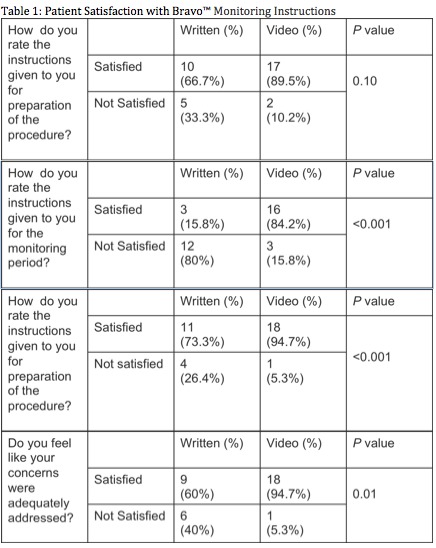|
Back to 2017 Posters
PREOPERATIVE VIDEO INSTRUCTIONS IMPROVE PATIENT COMPLIANCE AND SATISFACTION IN BRAVO PH MONITORING
Maureen D. Moore*, Katherine D. Gray, Suraj Panjwani, Yining Lu, Thomas J. Fahey, Cheguevera Afaneh, Rasa Zarnegar
Surgery, New York Presbyterian-Weill Cornell Medicine, New York, NY
Background: Patients often have difficulty understanding peri-procedural instructions given to them by healthcare providers. Studies have shown improved comprehension and compliance in patients who receive information in a variety of different formats such as audio/visual and text together. Using Bravo‚ĄĘ pH monitoring as a model procedure, we constructed a prospective, pilot study aimed to determine if multimodal preoperative instructions improve patient compliance and satisfaction.
Methods: We randomized 59 patients undergoing endoscopic placement of the Bravo‚ĄĘ pH monitoring capsule to receive either written preoperative instructions (control) or multimodal approach using written plus video instructions (intervention). Patients were contacted by phone one to two weeks post-procedure to complete a survey regarding their satisfaction with the instructions and procedure. Exclusion criteria were patients less than 18 years of age, did not complete telephone survey, and had prior pH study performed (Bravo‚ĄĘ). Our primary endpoints were patient satisfaction and compliance with monitoring instructions. Demographic data was analyzed including age, sex, race, and highest degree earned. Compliance was calculated on a 10-point scale using procedure-specific parameters over the 48-hour monitoring period such as adherence to an appropriate meal schedule, medication instructions, and knowledge on device function. Patient satisfaction was evaluated based on a five-point Likert scale.
Results: Thirty-four patients met our inclusion criteria yielding a surveyed response rate of 58%. Patient demographics in the control group (n=15) versus intervention group (n=19) were not statistically different. The intervention group had a significantly higher mean compliance score when compared to the control group (8.5 Ī 0.32 vs. 7.0 Ī 0.74; p=0.04). The majority of patients from the intervention group (95%) felt satisfied with instructions given to them in preparation for the procedure, while only 73% of the control group was satisfied (p<0.001). Furthermore, 84% of the intervention group versus 16% of control group was satisfied with the instructions they received for the monitoring period (p<0.001). The intervention group also had a significantly higher percentage of patients (95% vs. 53%) who felt they were given adequate amount of information to feel at ease during the test period (p=0.005) (Table 1).
Conclusion: Compared to standard written instructions, written in combination with video instructions improved patient compliance and satisfaction for the Bravo‚ĄĘ pH monitoring procedure. Use of video instructions as an adjunct to written instructions should be further evaluated for a broader range of medical procedures.

Back to 2017 Posters
|


